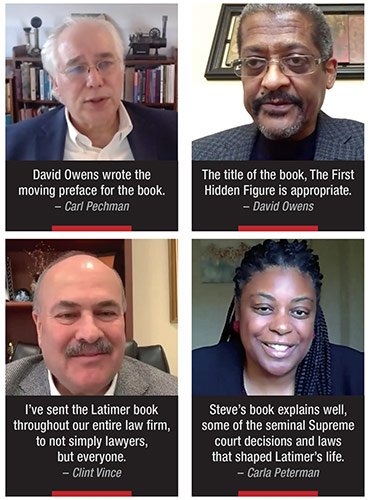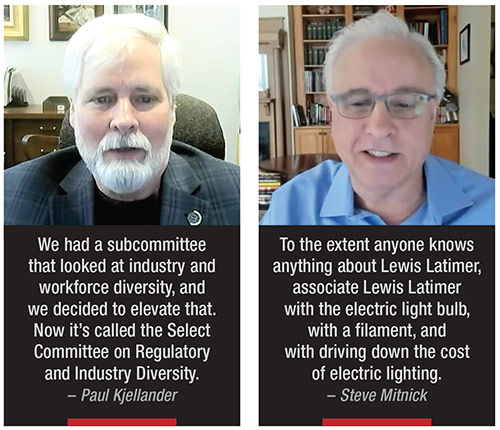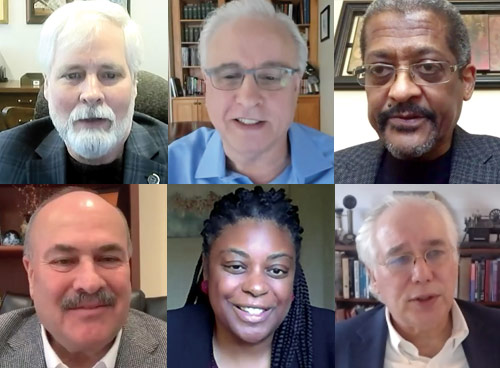NARUC's Winter Policy Summit
Carl Pechman is the Director of NRRI.


The 2021 NARUC Winter Policy Summit was held virtually and presided over by President Paul Kjellander. The Summit was an online success, with well attended sessions and panels on a slew of fascinating topics.
PUF's Executive Editor, Steve Mitnick, discussed his book, Lewis Latimer, The First Hidden Figure, with NRRI's Director, Carl Pechman, and an esteemed panel. Latimer, a prominent black engineer in the formation of the electric industry, played a critical role working with Alexander Graham Bell, Thomas Edison, and Hiram Maxim.
The book is part of a larger activity to build diversity in the electric industry, with profits helping establish the PUF Latimer Scholarship Fund administered by the American Association of Blacks in Energy.
Executive Editor, Public Utilities Fortnightly and Author, Lewis Latimer, The First Hidden Figure, Steve Mitnick: But for Lewis Latimer, the invention of the telephone wouldn't have been Alexander Graham Bell. He only got in by one hour into the patent office. Who did Bell's patent over that last Valentine's day weekend in 1876? It was Latimer.
Latimer self teaches himself patent law. Later, he started inventing. He has eight patents, and a few other patents were ascribed to others that were clearly Latimer's. He didn't get the credit. He didn't get any money.
He taught himself languages. He taught himself French when he was heading the installation of electric lighting in Montreal, so he could supervise. He taught himself German so he could read more scientific literature. When he was heading research and the libraries for the Edison companies, he taught himself Latin and Greek. He taught himself music and poetry. He was a great flute player.
Thomas Edison is revered, and he was a great man, but his patents were weak. You could say he didn't have the best light bulb. He was great at gathering R&D staff together, marshaling publicity, finance, and the best people, including ultimately Lewis Latimer.
He's not trained as a lawyer, to defend, enforce, and strengthen Edison's patent positions in North America, Europe and Asia, but Lewis Latimer did that. It's Lewis Latimer who's known for the famous global defense.
His home was in Queens, New York, and it's still preserved there at a beautiful Lewis Latimer Museum. His home was known to be the place, 1900 to 1925, where the great African-American poets, writers, and political thought educators would gather.
This was only a few years after emancipation, and Lewis Latimer came to be revered by the great captains of industry. Mostly men, who were starting the electricity industry, which was the boom of the 1880s, 1890s.
I was helped research by The Association of Edison Illuminating Companies. There are all sorts of papers about Lewis Latimer. Latimer kept journals. He wrote about a lack of respect from white men who he worked for, who he worked with, and he often supervised large groups of white men.
Yet he talks about how he often overcame that with the power of his intellect and his productivity. He was revered by AIEC. They had been associated with the development of the electric industry. When they wanted to form an exclusive elite club of this best and brightest, called The Edison Pioneers, they founded this group and all looked like me, with the exception of Lewis Latimer. They had to have Lewis Latimer.
Latimer's father, George, had been a slave. He and his wife were going to have a child and he did not want to have that child grow up in slavery. They disguised, hid in the hold of a ship, and made it to Baltimore.
At the time, Maryland was a slave state. His skin was light, so they pretended he was a master, and his wife was a slave. They made it to Philadelphia, then Massachusetts, a free State. George Latimer was in Boston for four days, when he was seen by his slave master's headman. That's bad luck.
George Latimer is arrested and charged with stealing himself because if a slave is property and he took his property away from his owner, he
stole himself. This was the biggest
and first big story of a fugitive slave that was going to be forced back into slavery and potentially down the river, as they said.
The abolitionist movement, which had a slow start, rocketed around protecting George Latimer and keeping him from slavery. They had to pay off the slave owner, then George Latimer and his family were free. Lewis Latimer was born four years later. Latimer was famous and revered throughout the abolitionist movement.
Edison in that December 1880 presentation to the press, claims the light bulb invention, and gets a patent. He's the inventor of the light bulb. The main competitor for Thomas Edison was the United States Electric Lighting Company and the head was Hiram Maxim.
Hiram Maxim in the late 1870s through 1882, was the head man in opposition to Thomas Edison. Maxim's bulb was better, mostly because of its filament.
Who was in charge of Maxim, of the lighting and electrical work at Maxim's company? Lewis Latimer. He had thirty white men working for him.
Latimer concentrated on a better filament, but not only a longer lasting carbon filament. If you look at that letter E, the connection to the bottom of the bulb, the connection to the electricity, Edison was having trouble with that.
Maxim wanted it to be known as the Maxim bulb. At the top of the filament, he had that shaped in an M, instead of just a loop. That was so everybody would know it was Hiram Maxim's bulb. Latimer didn't get credit for that. He had a couple of patents, but the credit went to the United States Electric Lighting Company.
One of the problems that Thomas Edison encountered was that it was expensive to manufacture light bulbs, especially filaments. Latimer comes up with this patent. It was applied for in 1881. This patent, the process of manufacturing carbons, came up with an automatic way to produce a lot of carbon filaments for the light bulb.
Edison quickly adopts this, pays no attention to the patent rights of Lewis Latimer, and was happy because he wanted to have electric lighting for everyone. It wouldn't have been possible unless they drove down the cost of the bulb.
They did this in large part because of this patent by Lewis Latimer. To the extent anyone knows anything about Lewis Latimer, and hopefully we're changing that, it's we associate Lewis Latimer with the electric light bulb, with a filament, and with driving down the cost of electric lighting.
Director, National Regulatory Research Institute, Carl Pechman: David Owens wrote the moving preface for the book. How do you view the lessons of the book from your personal experience in the industry and as a leading professional in the industry?
Former EEI Executive VP (Retired), Edison Electric Institute, David Owens: The title of the book, The First Hidden Figure is appropriate. In all the trials and tribulations Lewis had to go through, he never lost his focus. He had this unquenchable desire to learn and demonstrate to others that he was all about achievement.
Lewis was a person that surrounded himself with people of high esteem, and he got energy from them. He got a focus from them. I do the same thing. I try to surround myself with people that are positive, and knowledgeable.
Lewis surrounded himself with people that were dedicated to science and the arts. He surrounded himself with people that were great writers, and civil rights leaders. He surrounded himself with prominent and evolving people of color.
I try to do the same thing to the American Association of Blacks in Energy, where I've been a member for over forty years. I've had the honor of meeting esteemed people of color that were evolving in their careers, and many who were established.
I'm sure you know reading the book that Lewis was motivated by being around people that were about achievement. I try to surround myself with people all about achieving. Lewis was also a civil rights advocate.
I was active in the civil rights movement, in the '60s and the '70s. I saw a lot of change surrounding Dr. Martin Luther King, the civil rights laws, the Voting Rights Act, and the Housing Act. Lewis Latimer was outspoken on civil rights.
Lewis Latimer was integral in giving back, and that's what I try to do. Not only did he surround himself with people of high esteem and high culture, but he also felt it important to reach back and help those who were not as smart as he was, who didn't have the hard commitment and a strong thirst to improve.
I'm doing some things in Puerto Rico now to help rebuild the electric system. My career pales with Lewis Latimer's, but we have similarities, because he was someone who was discriminated against and it didn't get him down. He was the guy behind the scenes and never got the credit. He had a lot of humility, but he didn't have arrogance. He had a lot of love in his heart, was religious, and was a family man.
Carl Pechman: You're artist of the cover and many illustrations in the book, what did it mean for you to illustrate the book? Shift to the role of president of NARUC and talk about what NARUC is doing with diversity.
NARUC President, and President, Idaho Public Utilities Commission, Paul Kjellander: I had been fortunate to be working with Steve and PUF on a couple of paintings slated for the covers of the magazine and through those conversations, we got to the, hey, what do you do for fun?
Steve started talking about this book he was writing about someone I'd never heard of. He had so much passion about Lewis Latimer that I went and Googled him and started looking at images first because I am a visual person, and then looked into his career.
Steve asked if I'd be interested in doing the cover. The fun part was trying to find some elements for the painting, the still life. Now I have a bowler hat of native Beaver pelt that never did fit me. I have a pair of turn of the twentieth century gold rim glasses that I can't see through.
You asked about NARUC. Then-President Presley had issued a press release stating NARUC's position and from the transition from his time at NARUC to mine, we were looking at ways we could actualize some of the opportunities in front of us as an association to take a better look at ourselves, as well as find ways we could deal better with diversity issues that confront everyone.
We had a subcommittee of the board of directors that looked at industry and workforce diversity, and we decided to elevate that. Now it's called the Select Committee on Regulatory and Industry Diversity. We also ensured that the president of the association would be a member of that group. We had a constitutional change to make that happen.
Carl Pechman: Carla Peterman bridged the divide between Commissioner and utility. Pick up that conversation on the role of Commissions, utilities, and promoting diversity.
Senior VP Strategy and Regulatory Affairs, Southern California Edison, Carla Peterman: It reminds us that our industry did not develop in isolation. It was formed at the same time that you were having debates within our country about the rights and the role of African-Americans and Steve's book explains well, some of the seminal Supreme court decisions and laws that shaped Latimer's life.
We have to confront how systemic racism has shaped our institutions. I worked for Southern California Edison and that could have been Southern California Latimer under different circumstances, if he had been allowed to have full ownership of some of his contributions.
The same thing relates to Public Utilities Commissions. We've got dedicated Commissioners and Staff that have focused on, how do we ensure equal access to electricity for everyone, but our institutions have developed alongside some of these political developments. It's an important role for utility Commissions and utilities to look at our own homes, and see how we have embraced diversity, equity, and inclusion, to the extent we should have. Do we have representation in our utility Commissioners that reflect the populations that we serve?
Chair, Dentons U.S. Energy Practice, Clint Vince: One of the things that has made me happy is that Steve allowed me to send the book to every man, woman, and child that I know. I have done that, and I've sent the Latimer book throughout our entire law firm, to not simply lawyers, but everyone. I sent it to all my friends and clients.
Carl asked me about the NAACP versus FPC case. FPC being the Federal Power Commission, was a 1976 case decided by the Supreme Court, so it's modern history. In that case, the NAACP had simply asked that FERC — the FPC was the predecessor agency to FERC — require all the utilities regulated by FERC to have non-discriminatory practices and to intervene to assure that it was true.
The FPC took the position that they didn't have authority to do that under the Federal Power Act and the Natural Gas Act and the Supreme Court sustained that, saying that not even the public policy provision of those two Acts required to act in the way that the NAACP had requested. They carved out a very narrow exception, if a plaintiff could prove that the discriminatory practices created duplicative employees, for example, and that it impacted just and reasonable rates.
NARUC's Winter Policy Summit articles:
Category (Actual):
Department:
